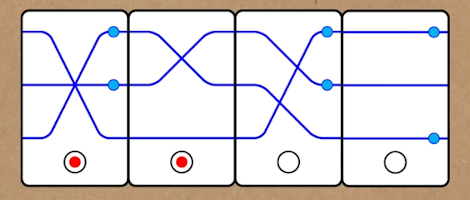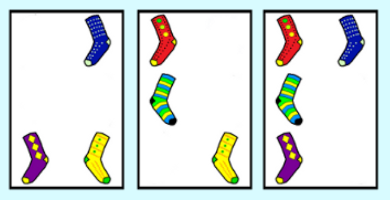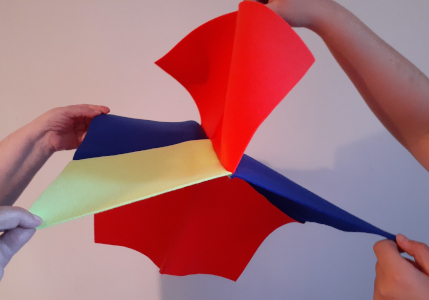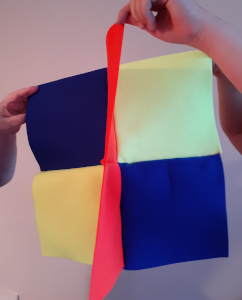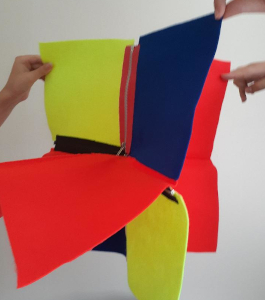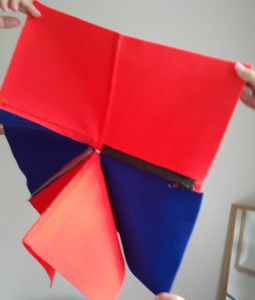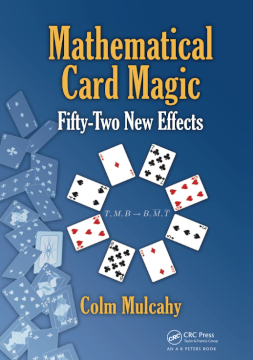The Game of SET for Groups (Part 2), jointly with Andrey Khesin
We recently wrote a blog post on how to generalize the game of SET and promised to continue. Here we are. But first, a reminder of what the game of SET is.
In the game of SET, we have 81 cards, each containing one, two, or three of the same object. The object is green, red, or purple, the shape is squiggly, oval, or diamond, and the shading is empty, full, or stripped. Three cards form a set if, for every feature, the attributes are all the same or all different. An example of a set with all features different is shown below. By the way, such sets are usually more difficult to spot. In the game, you need to find sets as fast as you can.
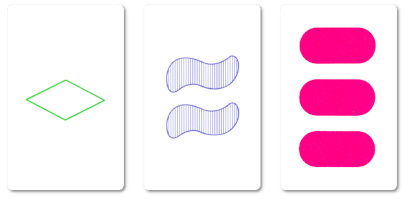
If we assign each attribute value a number 0, 1, or 2, we get an equivalent definition of a set. Three cards form a set if and only if the values for each feature sum to zero modulo 3. Thus, we can see our cards as vectors in the space F34. Three vectors form a set if they sum up to 0.
The generalizations we described in the previous post, were the following. We pick a different group and define a set as a few cards that might need to be in a specific order that multiply to the group’s identity.
However, there is a different way to generalize sets to groups. Three cards that form a set in a classical game of SET, taken in any order, form an arithmetic progression. In other words, if a, b, and c form a set, then vectors b−a and c−b are the same. We can check this. We have c−b = c−(c+b+a)−b =−2b−a = b−a.
Thus, we can generalize the game of SET differently. Suppose cards are vectors in some space. We say three of them, a, b, and c, form a set if and only if b−a = c−b. Now, the order becomes important, similar to our previous generalization. We do not need to use commutative groups like vector spaces. For any group, our condition is equivalent to ba-1 = cb-1. Thus, c = ba-1b.
Interestingly, we do not care much about the identity card, meaning the card deck is a torsor. We introduced the notion of a torsor before, which informally is a group that forgets about its identity. Now, let’s check possible examples.
Suppose the values of one attribute correspond to Z4. This game is not very inspiring as two values, a=0 and b=2, can be completed to a set with the third card, which equals c=(0,0,0) and is already used. The next interesting example is Z5. Here, values a=0 and b=2 can be completed to a third value c=4. We will leave it to the reader to check that for any two cards, a and b, the third card, c, differs from both a and b.
To make it more visual, we can use a pentagon with one marked direction. We fix the pentagon in space. In this case, three cards form a set if and only if the directions of the first and the third card are symmetric with respect to the direction of the second card. If we want to use three pentagons, we can reuse the cards from the game C53T, we described in our previous post. To make this game more visual, we can use three pentagons. We can mark each coordinate with a direction on the corresponding pentagon. The colors are to allow players to visually process the cards faster. For theoretical purposes, the colors can be ignored. Also, the pentagons themselves have different intensities of gray to emphasize that the game is played on each of them separately and also help choose the top of the card.
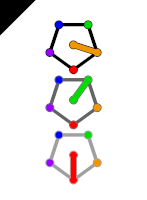

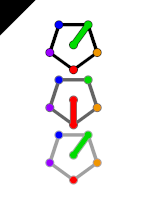
Let us go back and calculate when it is possible that the element that completes a set is already used. If our initial elements are a and b, then we need ba-1b to complete a set. If this element is equal to b, then a = b, which contradicts the assumption that we start with two different cards. Suppose ba-1b = a, then, equivalently (ba-1)2 = 1. The new element can be the one that is already used if and only if the group contains elements of order 2.
Can we use other decks we described in the previous post? Consider the game ProSet/Socks. The group is commutative, and every element is of order 2, which means ba-1b is always a. We can’t use the deck at all! What about the EvenQuads deck? It can be viewed as Z43, so it is possible that we can’t complete any two cards to a set. However, there is a bigger problem with the deck. To play with it, we need to actually assign values to colors and shapes. We are saying that even if we decide to use the group, we should make different cards! For example, we can style the cards as squares like the pentagons above.
We also mentioned in the previous post the group, which is the wreath product of S2 and S3. Consider the following example of two cards that were screen-printed from the Numberphile video on the variations of the game of SET.


The first card, a, is the inverse of itself, so the third card we are looking for is described as the product bab, which we can visualize as the following. If we ignore the beads, the card that completes the set is a. Luckily, if we do not ignore the beads, it is not a; we need to add two beads to a.



The product of permutations is difficult to visualize, so playing this game with the cards in the Numberphile video might be difficult. The good news is that this group can be visualized in many different ways:
- The group of symmetries of a cube, meaning its rotations and reflections;
- The group of symmetries of an octahedron, meaning its rotations and reflection;
- The wreath product of S2 and S3;
- The direct product of S4 and S2.
We want to show you a beautiful deck from the tsetse website that allows you to use any one of the four definitions to play the game. The game is called OCTA Set, as the underlying group is called an octahedral group. An example of a set is in the image below, where the top and bottom shapes represent the same element of the group. Moreover, the deck is a torsor: there is no the identity card.

- The top shape represents an octahedron where the opposite faces are the same color. Thus, the top shape shows a unique rotation of an octahedron. All the swirls are the same in the image, but in other cards, the swirl could be white. Two different swirls mean that the octahedron needs to be reflected to get from one shape to the other. In our example above, no reflection is involved, so all the swirls are black.
- We can ignore that the top shape represents an octahedron and only look at the choice of colors. The changes of colors represent a permutation in S4 and a swirl represents an element in S2.
- The bottom shape represents a cube where the opposite faces are the same color. One of the faces is solid, and the opposite face is hollow. This way, one can reconstruct the complete shape of a cube by the top three faces.
- We can ignore that the top shape represents a cube and only look at the choice of colors. The colors form a permutation, and the beads correspond to changing the hollowness of a color. When viewing the cube this way, the permutation acting on the colors is S3, and each color has its hollowness associated with an element of S2. This exactly corresponds to the wreath product of S3 and S2.
Let us prove that this is a set. Consider the bottom cube shape. Comparing the first two cards, the top face doesn’t change. We can see that the symmetry of the cube is the 90-degree clockwise rotation around the line that goes through the centers of green faces. In such a rotation, the left face on the second card keeps the color from the first card, while the right face takes the color from the left face on the first card and swaps hollowness. We see that the third cube completes the set.
For another proof, let us look at the top shape and discuss what happens with the permutation of colors when changing from the first card to the second. The left color moves to the bottom, the bottom color to the right, the right color to the center, and the center color to the left. Not surprisingly, we got a cyclic permutation of order 4, similar to a 90-degree rotation being of order 4. The same thing happens when moving from the left to the right. The swirl stays the same.
As we mentioned, when you play this game and pick two cards then calculate what card completes the set, you might discover that it is one of the cards you picked. The probability that two cards in a specific order can’t be completed into a set is the same as the probability of picking a random element in our group and discovering that it has order 2. The symmetric group S4 has 9 elements of order 2. Thus, the direct product with S2 has 19 elements of order 2, giving a probability of 19/48. For completeness, this group also has 8 elements of order 3, 12 elements of order 4, 8 elements of order 6, not to mention the identity of order 1.
If ba-1 is an element of order three, then the cards a, b, and the card c that completes the set form a set when they are taken in any order. As a tradition in mathematical writing, we leave it to the reader to check that fact. Just a reminder that in the game of SET, the group element ba-1 always has order 3.
Notably, there was nothing special or extraordinary about the group discussed above. It has a pretty visualization as a cube or octahedron, but is not otherwise particularly interesting. The reason why this group allowed for these two platonic solids to be used to visualize it is because the cube is dual to the octahedron. But we could have similarly used any group to play set! One such example might consider using the group of symmetries of the other pair of dual platonic solids, the icosahedron and the dodecahedron. This group is actually equivalent to A5, also known as the alternating group of order 5, which consists of all even permutations of five elements. The tsetse website we mentioned above contains an implementation of such a game called A5SET (pronounced “asset”). The design of the site, games, and cards was done by Andrew Tockman and Della Hendrickson.
The world is full of groups and symmetries. Any group can be turned into a game of SET!
Share: